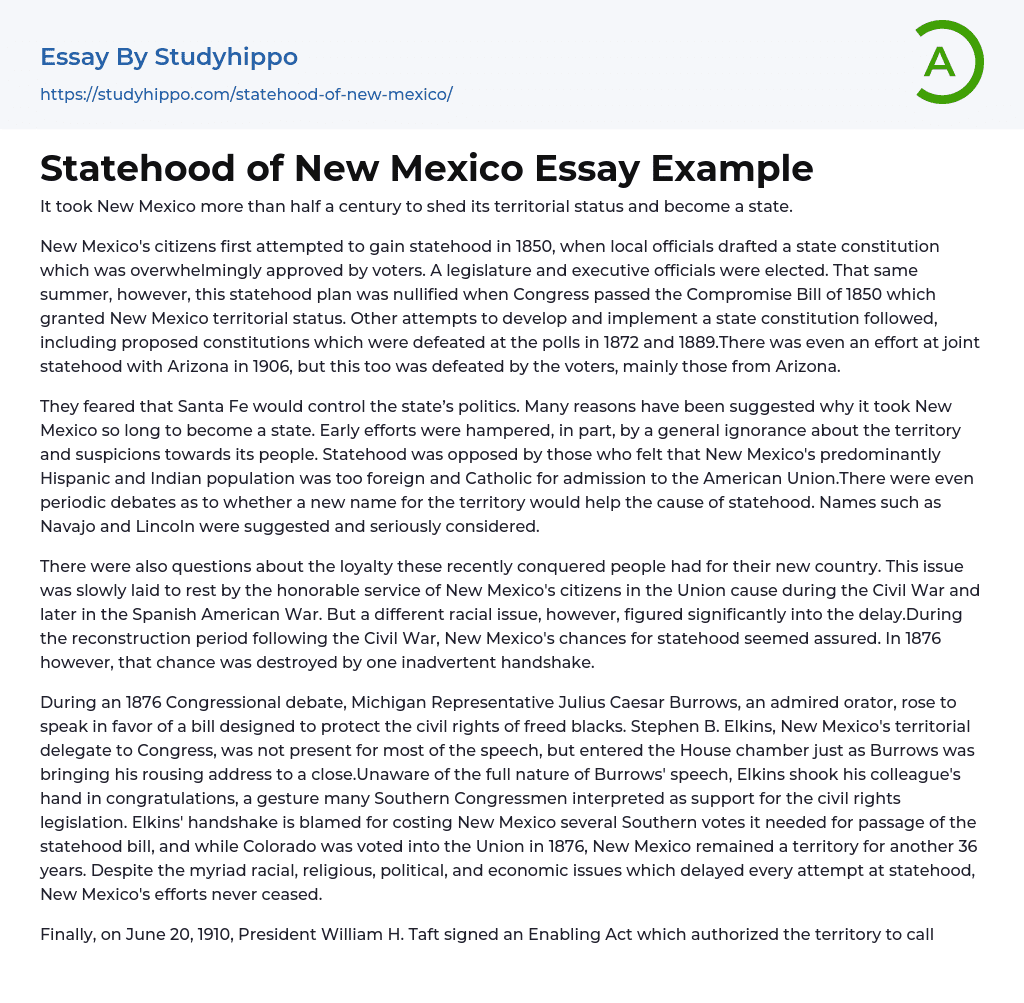It took more than five decades for New Mexico to move from being a territory to achieving statehood.
In 1850, citizens of New Mexico made their first attempt to become a state by drafting a state constitution which was approved by voters and resulted in the election of a legislature and executive officials. However, their statehood plan was nullified the same summer when Congress granted New Mexico territorial status through the Compromise Bill of 1850. Despite subsequent attempts to develop and implement a state constitution, proposed constitutions were defeated at polls in 1872 and 1889. Even a joint statehood effort with Arizona in 1906 was defeated by voters, particularly those in Arizona.
The state's politics were at risk of being controlled by Santa Fe, causing fear. Various reasons have been proposed for New Mexico's delayed statehood. Lack of knowledge about the territory and distrust
...towards its inhabitants hindered early efforts. Some opposed statehood due to the belief that the predominantly Hispanic and Indian population was too foreign and Catholic for inclusion in the American Union. Discussions even occurred about changing the territory's name to aid statehood, with suggestions like Navajo and Lincoln being seriously considered.
Questions were raised regarding the loyalty of the newly conquered people towards their new country. However, the honorable service of New Mexico's citizens during the Civil War and the Spanish American War helped alleviate this concern. Despite this, a separate racial issue caused a delay. New Mexico's prospects for statehood were promising during the reconstruction period after the Civil War, but in 1876, one accidental handshake ruined that opportunity.
During a congressional debate in 1876, Michigan Representative Julius Caesar Burrows gave a
powerful speech endorsing a bill to protect the rights of freed African Americans. As he finished his speech, New Mexico's territorial delegate to Congress, Stephen B. Elkins, entered the room and praised his colleague without realizing the full extent of his remarks. This prompted many Southern congressmen to view Elkins' action as support for civil rights legislation, which led to several lost votes needed for statehood approval. Consequently, while Colorado achieved statehood that year, New Mexico remained a territory for another 36 years due to various issues such as racial inequality, religious dissimilarities and economic difficulties that hindered its progress towards statehood despite unwavering dedication.
President William H. Taft signed an Enabling Act in 1910, granting permission for the territory to conduct a constitutional convention and attain statehood. On October 3rd of that year, representatives from every county convened in Santa Fe to create a constitution. The constitution was ratified by voters on January 21, 1911, advancing New Mexico's progress towards becoming part of the United States of America. A distinguished delegation from New Mexico visited Washington D.C. in celebration of this historic event.
President Taft signed the proclamation that officially welcomed New Mexico as the 47th state. He signed the document on January 6, 1912, at 1:35 P.M. After completing the long-awaited act, Taft addressed the delegation and expressed, "Well, it is all over."
Granting you existence and wishing you good health brings me happiness. On January 15, 1912, William C. McDonald became the first Governor of the State of New Mexico after a difficult process culminated in achieving statehood. His inauguration on the steps of the Santa Fe capitol building marked this milestone moment. The state
faced the subsequent challenge of proving its worth as a valuable member of the Union.
Over time, New Mexico has undergone significant transformations caused by diverse factors such as world wars and different economic and political advancements. These changes have surpassed the expectations of its original inhabitants including Spanish conquerors, Mexican farmers, French trappers, American soldiers, and Jewish merchants. Nevertheless, every group that established itself in New Mexico has played a role in shaping it into their own home.
- Alaska essays
- Boston essays
- Brazil essays
- California essays
- Canada essays
- Chicago essays
- Costa Rica essays
- Florida essays
- Hawaii essays
- Latin America essays
- Los Angeles essays
- Mexico essays
- Slavery In America essays
- Usa essays
- Virginia essays
- Washington essays
- San francisco essays
- Tennessee essays
- The Us Constitution essays
- U.S. Securities And Exchange Commission essays
- U.S. State essays
- United Parcel Service essays
- United States Postal Service essays
- Bureaucracy essays
- Congress essays
- President essays
- Separation Of Powers essays
- United States Congress essays




